Television has always been more than storytelling. It is also visual history, resurrecting the silhouettes, fashions, and beauty trends that defined entire decades. Hairstyles, in particular, hold an outsized role.
They do not just frame a character’s face; they telegraph class, confidence, mood, and even politics before a single line of dialogue is spoken. When a period drama invests in authentic hairstyling, the viewer is transported. Suddenly, the 1920s are no longer static black-and-white photos in an archive — they are alive, moving, breathing, and glamorous.
Vintage hairstyles are especially powerful because they carry symbolism. A sculpted wave in the 1920s represented rebellion against Victorian norms. A victory roll in the 1940s was both practical and patriotic, a nod to women entering factories while also celebrating wartime resolve. A towering beehive in the 1960s signaled prosperity, optimism, and polished suburban living.
These styles are beautiful on their own, but what makes them iconic is the way certain television characters wear them. When the right hairstyle meets the right character, the result is unforgettable.
This article looks at thirteen standout characters from some of the most beloved television dramas of the past two decades. Each of these women embodies a vintage hairstyle so perfectly that the look becomes synonymous with the role. Along the way, we’ll explore why these hairstyles mattered in their time, how the series used them to tell stories, and how you can adapt them today without slipping into full costume territory.
Related: Viking Hairstyles to try today
1. Margaret Thompson – Boardwalk Empire (Finger Waves, 1920s)
Boardwalk Empire recreated the chaotic glamour of Prohibition-era Atlantic City, and Margaret Thompson became its most elegant style ambassador. Played by Kelly Macdonald, Margaret begins as a shop girl but rises to prominence as the partner of Nucky Thompson. Her transformation is written not only in her dialogue but also in her hair.
Margaret’s look is dominated by immaculate finger waves, a hairstyle that defined the 1920s. Unlike loose curls, finger waves hug the skull, creating sculpted “S” shapes that shimmer under dim speakeasy lights. The style was the perfect metaphor for Margaret’s duality.
On one hand, it represented her step into modernity — cutting away the heavy Edwardian styles of the past. On the other, the discipline of the waves mirrored her need for control in a dangerous world.

The finger wave is one of the trickiest vintage looks to master because it requires patience and precision. Wet hair is combed into ridges and clamped with wave clips until set.
For Boardwalk Empire, the stylists used it to show how Margaret was never a passive bystander. Her hairstyle announced her as a woman of independence and taste, a character who demanded to be taken seriously in an era that often silenced women.
2. Lady Mary Crawley – Downton Abbey (The Flapper Bob, 1920s)
If Margaret embodied the Jazz Age through waves, Lady Mary Crawley gave television audiences one of the most talked-about bobs in recent memory. Played by Michelle Dockery, Mary’s decision to cut her hair short in Downton Abbey’s later seasons carried symbolic weight.
In a show that constantly wrestled with tradition and change, her bob was more than style — it was revolution.
The bob was the ultimate rejection of Edwardian femininity, which prized long, heavy tresses arranged in elaborate updos. By cutting her hair to jaw length, Lady Mary signaled a complete embrace of the modern woman.
On screen, her sharp bob framed her aristocratic features, making her appear both daring and chic. It also communicated to viewers that Mary was not afraid to shed the trappings of the past, even if it shocked her family.

The cultural resonance of the bob cannot be overstated. It became a shorthand for independence, associated with flappers who smoked, danced, and claimed new freedoms. By anchoring that transformation in a central character, Downton Abbey reminded us that haircuts are never just cosmetic; they are often statements of identity.
3. Polly Gray – Peaky Blinders (Marcel Waves, 1920s–1930s)
Few characters project authority as effortlessly as Polly Gray, the matriarch of the Shelby family in Peaky Blinders. Played by Helen McCrory, Polly is fierce, calculating, and impossible to overlook. Her hairstyle played a vital role in shaping that impression.
Polly’s signature look was the marcel wave, a heat-styled cousin of the finger wave. Instead of hand-molding curls with gel, marcel waves used heated irons to clamp the hair into alternating ridges.
The result was shinier, sharper, and more industrial than finger waves — perfectly suited for the gritty world of Birmingham gangsters.

The marcel wave’s sharp ridges symbolized control, precision, and authority. For Polly, the style amplified her role as strategist and protector of the family empire.
It was glamorous, yes, but it was also armor. Audiences watching Peaky Blinders saw instantly that Polly was not a woman to be trifled with. Her hairstyle was her crown, announcing her as queen of a criminal dynasty.
4. Peggy Carter – Agent Carter (Victory Rolls, 1940s)
Marvel’s Agent Carter didn’t just give fans a female superhero; it gave us one of the most iconic hairstyles of the 1940s back on primetime television. Hayley Atwell’s Peggy Carter wore victory rolls with a mix of style and strength that perfectly suited her dual role as a fashion-forward woman and a wartime agent.
Victory rolls emerged during World War II as both practical and patriotic. Women needed hair out of the way for factory work, but they also wanted to maintain glamour.
Rolling sections of hair upward and pinning them at the crown solved both problems, creating a distinctive “V” shape that also served as a subtle nod to the Allied victory slogan.
On screen, Peggy’s victory rolls became a visual signature. They showed her as fashionable yet functional, feminine yet formidable.
In many ways, they symbolized the larger themes of the show: women claiming space in male-dominated environments while refusing to sacrifice their identity. To this day, Peggy Carter cosplay almost always includes her iconic red lipstick — and her victory rolls.
5. Edith Crawley – Downton Abbey (Gibson Tuck, 1910s)
While Lady Mary embraced the sharpness of the bob, her sister Edith often embodied an earlier ideal of femininity. Edith’s most memorable hairstyle was the Gibson tuck, a style that dominated the 1910s and reflected grace and restraint.
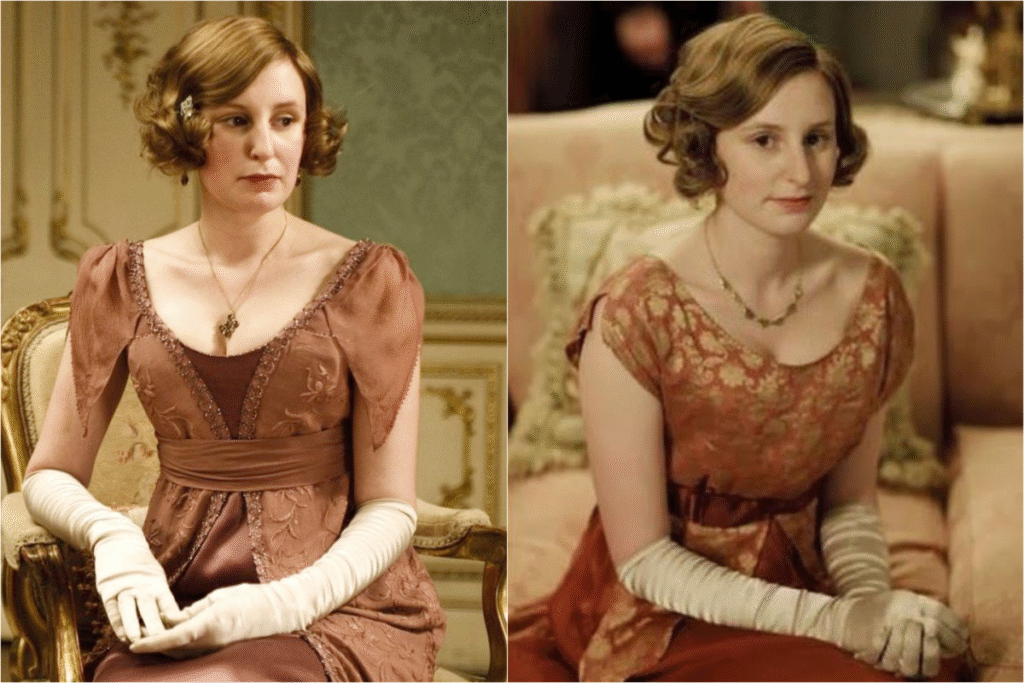
The Gibson tuck gathers hair at the nape and rolls it into a soft cradle, often with gentle fullness at the sides. On Downton Abbey, this look suited Edith’s character perfectly.
Unlike Mary’s bold independence, Edith’s storylines often revolved around tradition, duty, and the search for acceptance. Her tucked hair reinforced her quieter role while still allowing her beauty to shine.
Historically, the Gibson tuck was associated with the “Gibson Girl,” an early 20th-century ideal of femininity. It was elegant but not ostentatious, refined but not flashy.
Edith’s use of the style told audiences that she was loyal to tradition, even as the world around her changed. By juxtaposing her tucked hair with Mary’s bob, the show highlighted the generational and personal divides within the Crawley family.
6. Miriam “Midge” Maisel – The Marvelous Mrs. Maisel (Pin Curls, 1950s)
Rachel Brosnahan’s portrayal of Midge Maisel is inseparable from her immaculate hair. Her pin curls are bouncy, polished, and full of energy, perfectly mirroring her quick wit and relentless charm.
More than a hairstyle, her curls symbolized the polished image of the 1950s housewife — one that Midge both embraced and subverted.
Pin curls were the most accessible way for women to achieve lasting waves without heat tools. Damp hair was wrapped around fingers, pinned flat against the scalp, and left overnight. The next morning, the curls were brushed into glossy waves.
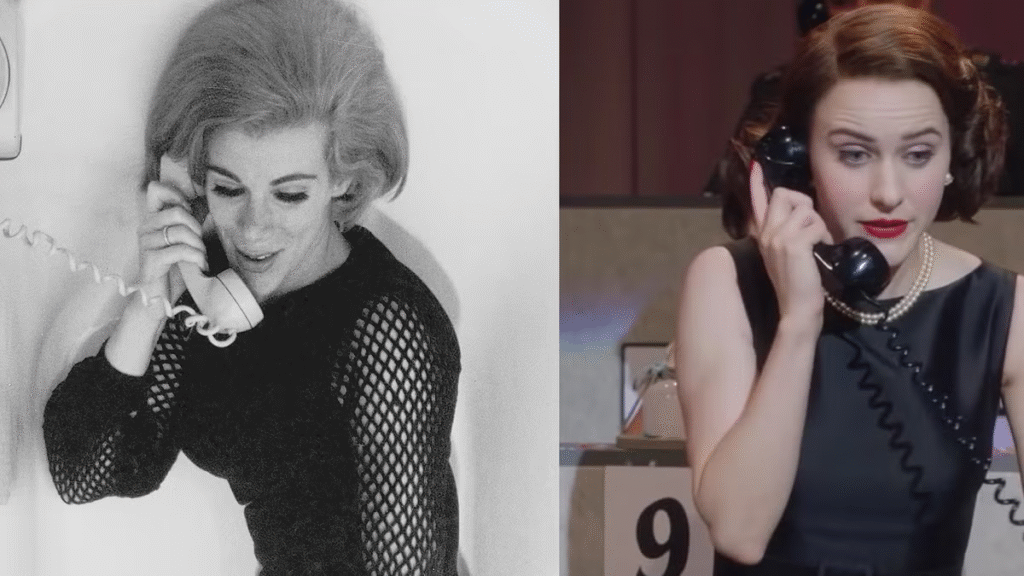
For Midge, this nightly ritual signified devotion to beauty standards, but the results — voluminous curls — also became her calling card.
On screen, the curls carried narrative weight. When Midge’s life unraveled after her husband left, her curls remained perfect, almost ironically.
They embodied the contradiction of her character: a woman who appeared flawless on the outside while her private world collapsed. Later, as she rose as a comedian, the same curls became a shield of glamour that allowed her to step onto stage with confidence.
7. Betty Draper – Mad Men (The Beehive, 1960s)
If there was ever a hairstyle that encapsulated suburban perfection, it was Betty Draper’s beehive in Mad Men. Played by January Jones, Betty’s towering style reflected the cultural mood of the early 1960s — one obsessed with image, consumerism, and control.
The beehive, invented in 1960, involved backcombing hair at the crown into immense volume, smoothing the outer layer, and sculpting it into a rounded “hive.” It was dramatic, polished, and impossible to miss.
For Betty, the beehive was more than fashion; it was armor. Her flawless exterior mirrored her perfectly curated home life, concealing deep loneliness and dissatisfaction.
Culturally, the beehive was linked to icons like Audrey Hepburn and The Supremes. On Mad Men, it became shorthand for Betty’s entrapment within idealized femininity.
Audiences saw how much effort went into maintaining the hive, just as Betty expended energy maintaining appearances. Her hair told the story of a woman who looked perfect but felt powerless.
8. Joan Holloway – Mad Men (French Twist, 1960s)
While Betty floated in her bouffant world of suburban ennui, Joan Holloway owned the office with her sleek French twist. Played by Christina Hendricks, Joan embodied confidence, sensuality, and authority. Her hairstyle was central to that image.
The French twist was a sophisticated updo in which hair was swept to one side, rolled vertically, and pinned at the back of the head. It exuded elegance without excess. On Joan, it became a visual weapon — polished enough for the workplace, glamorous enough for the evening.
The twist mirrored Joan’s ability to control the chaotic energy of Sterling Cooper’s office. Her hair never seemed out of place, no matter the tension of the scene. This precision reinforced her role as both gatekeeper and temptress. It also highlighted her power: while men underestimated her as a secretary, her sleek twist suggested she was always one step ahead.
9. Queen Elizabeth II – The Crown (Bouffant, 1950s–60s)
Claire Foy’s portrayal of a young Queen Elizabeth II in The Crown reintroduced viewers to one of the most regal styles of the mid-20th century: the bouffant. While not as exaggerated as the beehive, the bouffant used teasing and volume at the crown to create height, balanced by soft sides and curls.
For Elizabeth, the bouffant symbolized authority and modernity. It was dignified yet fashionable, a perfect middle ground for a monarch straddling tradition and change.
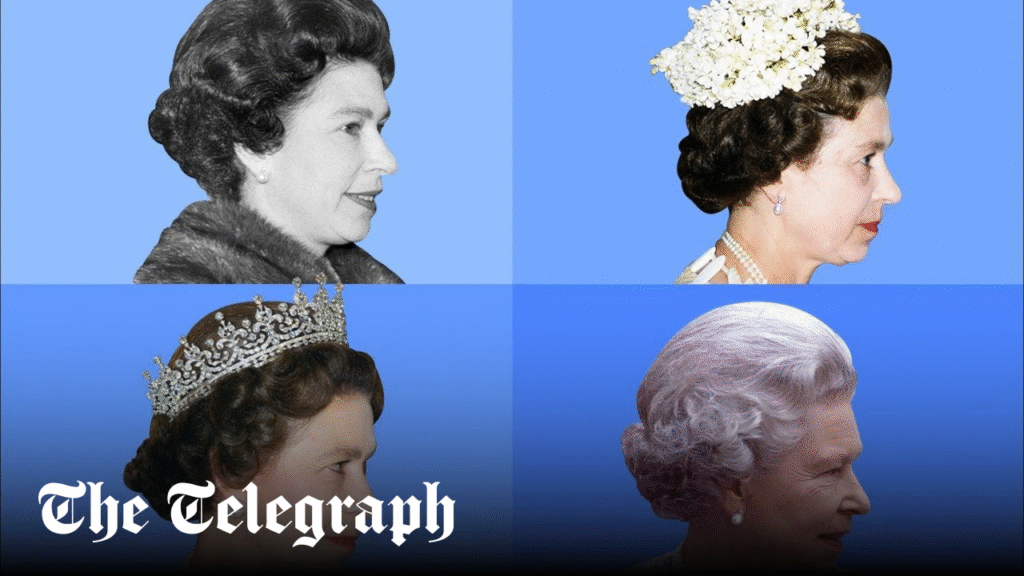
The style gave her a youthful softness but also a visible crown-like silhouette. In state functions, the bouffant reinforced her majesty; in domestic scenes, it reflected the tidy expectations of 1950s womanhood.
The series used Elizabeth’s bouffant as a timeline marker. As the monarchy navigated political crises, her hair shifted subtly, reflecting both aging and evolving fashion. The bouffant era in The Crown underscored the Queen’s efforts to remain modern without undermining her regal image.
10. Beth Harmon – The Queen’s Gambit (Mod Bob with Bettie Bangs, 1960s)
Few recent television characters have sparked a hairstyle revival like Anya Taylor-Joy’s Beth Harmon in The Queen’s Gambit. Her mod-era bob, complete with blunt Bettie bangs, became instantly iconic.
Beth’s hair mirrored her personal evolution. Early in the series, her bangs were softer, her bob more girlish, reflecting her uncertain youth.

As she grew into a world-class chess player, her hair sharpened — clean lines, bold waves, and precise bangs. By the time she faced her Soviet rivals, her hair had become a crown of intellect and confidence.
The mod bob itself was a defining 1960s cut, popularized in London by Vidal Sassoon. Its geometric precision matched the era’s fascination with futurism and modern art.
On Beth, the bob fused beauty with intellect, overturning stereotypes of both chess and femininity. It reminded audiences that style can amplify strength without diminishing seriousness.
11. Sister Bernadette – Call the Midwife (Side Roll, 1950s)
In Call the Midwife, set in East London during the postwar years, Sister Bernadette (played by Laura Main) brought understated elegance to her role as a nun and nurse. Her hair was often arranged in soft side rolls, a style that was modest but distinctly mid-century.
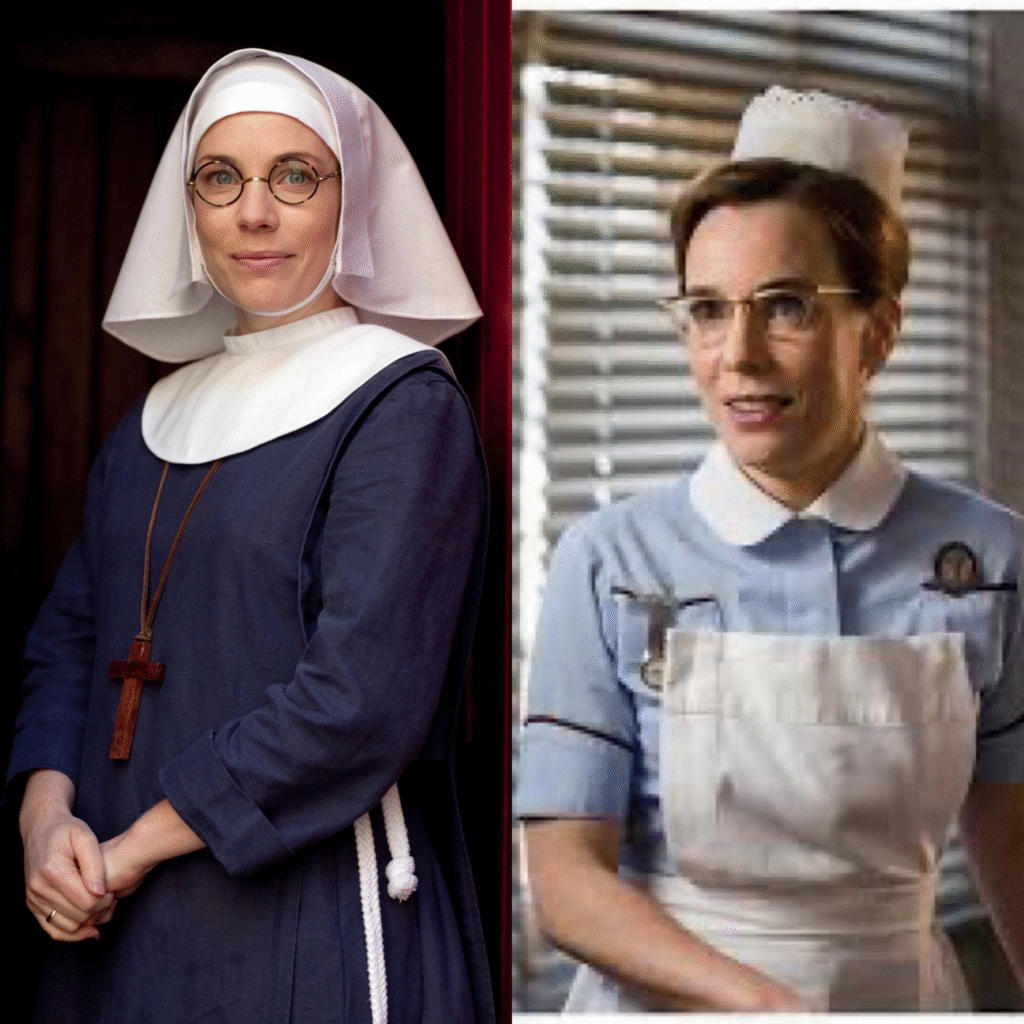
Side rolls were practical: they kept hair neat under a cap but also gave shape and definition to the face. For Sister Bernadette, the style emphasized discipline and humility while still allowing her femininity to show. It reflected the values of the era — neatness, order, and grace — especially in a show about care, service, and quiet resilience.
Her side rolls also symbolized restraint. Unlike the towering bouffants or playful pin curls of her contemporaries, Bernadette’s hair was subdued. Yet this very restraint gave her character strength. Audiences recognized her as a woman who embodied dignity without needing glamour.
12. Maggie Ryan – Pan Am (The Flip, 1960s)
The ABC drama Pan Am may have been short-lived, but it gave us a feast of early-1960s style. Maggie Ryan, played by Christina Ricci, epitomized the stewardess glamour of the jet age. Her hairstyle of choice was the hair flip — sleek at the crown with ends curled outward in a playful arc.
The flip captured the optimism of the era. It was tidy enough for work but had a youthful bounce that suggested adventure. Stewardesses were marketed as cultural icons of sophistication, and their hair was as much a part of the uniform as their powder-blue suits.
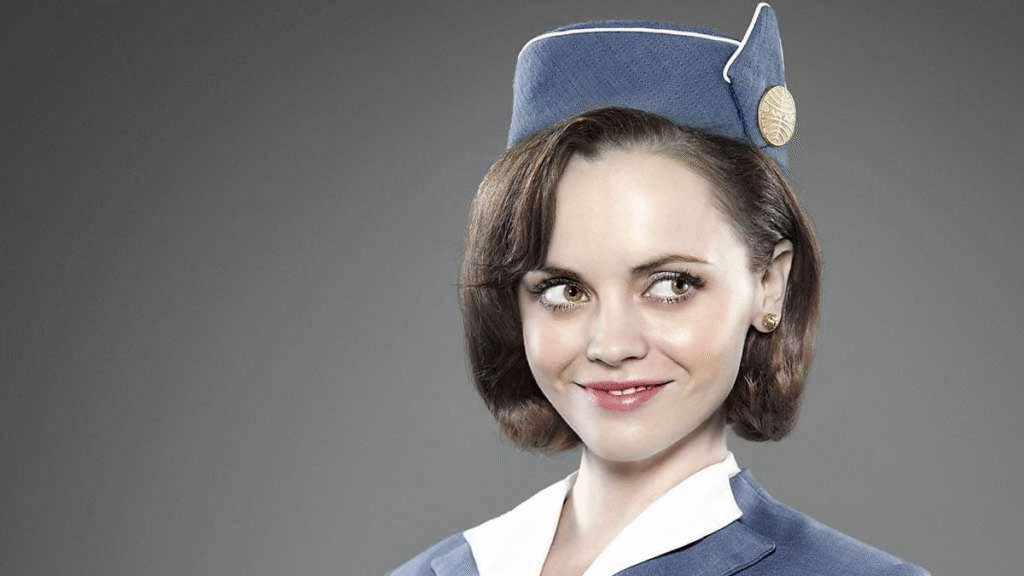
Maggie’s flip made her approachable yet polished, suggesting both professionalism and charm. For modern audiences, the flip is pure nostalgia — evoking an era when flying was glamorous, and hair carried the excitement of new horizons.
13. Joan Crawford – Feud: Bette and Joan (Hollywood Waves, 1960s)
No one wielded hair as weapon and crown quite like Joan Crawford. In Feud: Bette and Joan, Jessica Lange portrayed the aging star with sweeping Hollywood waves — large, defined curls that cascaded like liquid.
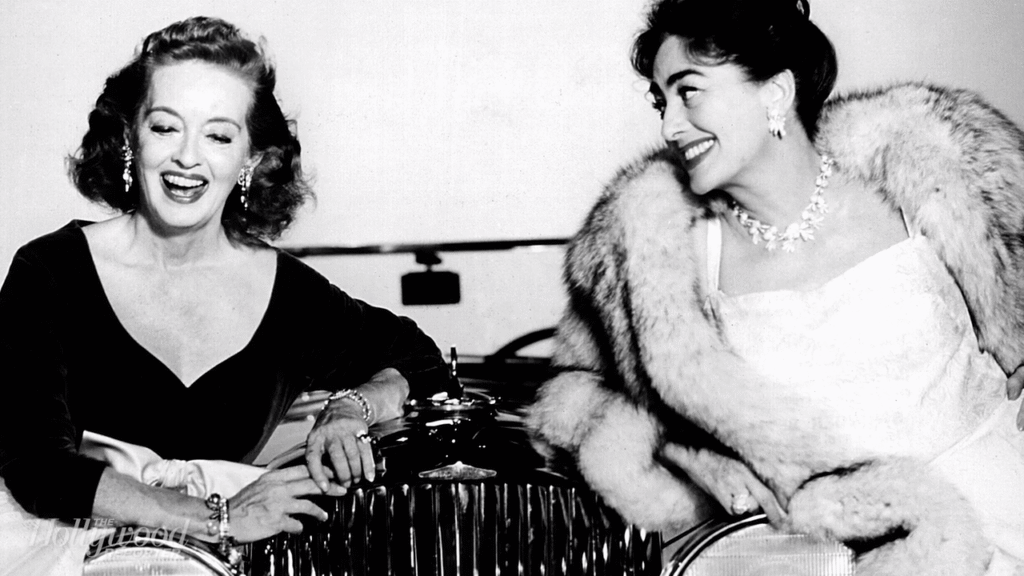
Hollywood waves were a throwback by the 1960s, belonging more to the golden age of the 1930s and 40s. But for Crawford, they were essential. They represented her refusal to relinquish her glamour, even as the industry shifted toward new ideals. The waves projected authority and old-school star power.
On screen, the waves reinforced Crawford’s determination to hold her place against Bette Davis. They were not just a hairstyle but a survival tactic. Each curl was a reminder that she would not surrender her legacy quietly. For viewers, the waves became a poignant image of clinging to timeless beauty in a world obsessed with the new.
Tools and Styling Essentials for Recreating Vintage Looks
While each character’s hairstyle is unique, most of these vintage looks rely on a common toolkit. If you want to bring retro television glamour into your own routine, start with these basics:
- Combs and Rattail Combs: Essential for sectioning and precision work.
- Bobby Pins and Hair Clips: The backbone of almost every vintage updo, from victory rolls to French twists. Crossing pins into an “X” adds extra hold.
- Foam Rollers and Pin Curl Clips: Heatless tools that create long-lasting curls. Many vintage looks were built overnight with these.
- Setting Lotion and Hairspray: Setting lotion provides hold before styling, while hairspray locks everything into place afterward.
- Curling Irons and Marcel Irons: For waves and ridges that can’t be achieved with rollers alone.
- Hairnets and Scarves: Historically, women wore these to preserve curls between washings. They’re just as useful now for extending a style.
Wearing Vintage Styles Today
The challenge of vintage hairstyles is avoiding the “costume” effect. Television shows often exaggerate for period accuracy, but in daily life, subtlety works best. To modernize:
- Simplify the shape. Instead of a towering beehive, try a softer bouffant with moderate height.
- Loosen the finish. Finger waves look striking when structured, but brushing them into softer waves makes them contemporary.
- Pair with modern fashion. A French twist with a minimalist outfit feels chic rather than retro.
- Focus on one element. Instead of a full 1950s set, try pin curls just at the front to frame the face.
Vintage hairstyles thrive when they’re used as inspiration rather than strict replication. They carry echoes of the past but still leave room for personal expression.
Conclusion: The Timeless Power of Hair
From Margaret Thompson’s finger waves to Beth Harmon’s mod bob, television has revived vintage hairstyles in ways that feel immediate and alive. These looks are more than pretty arrangements of hair — they are cultural symbols. They represent liberation, resilience, femininity, and power, each woven into the character’s story.
That is why viewers remember not just the plotlines but the silhouettes of hair: Peggy Carter’s victory rolls as she saves the day, Betty Draper’s beehive standing tall against suburban suffocation, Joan Crawford’s Hollywood waves battling irrelevance with grandeur.
The lasting appeal of these hairstyles lies in their ability to bridge time. They remind us that fashion is cyclical, that identity can be shaped by something as simple as a curl or a tuck, and that the beauty of the past is never truly gone. With a few pins, a comb, and some patience, anyone today can step into the glamour of yesterday.